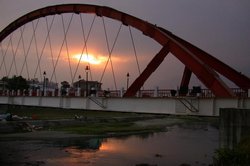Hualien
|
|
Hualien City (花蓮市) is the capital of Hualien County, Taiwan Province of the Republic of China. It is on the coast of the Pacific Ocean.
| Contents |
History
According to The Record of Hualien County (花蓮縣志), the place was originally called Qilai (奇萊), but this name was abandoned by the Japanese in early 20th century because it sounds like "despice" in Japanese and used Hualien instead. Hualien is an approximate homonym of Huilang (洄瀾), which means "recurring waves (of the Pacific Ocean)".
The Spaniards tried to mine gold in Hualien in 1622. Permanent settlements began in 1851, when 2,200 Han Chinese farmers led by Huang Afeng (黃阿鳳) of Taipei arrived at Fengchuan. In 1875, more farmers, led by Lin Cang'an (林蒼安) of Yilan, settled at Fengchuan. But by the time of the Sino-Japanese War (1894-1895), when Hualien City, along with the rest of Taiwan, was ceded to Japan, there were still not many settlers in Hualien. In about 1912, the city expanded to Guohua and Guoan Villages, a region later known as Old New Port (舊新港). Around 1923, the city continued to expand to Aolang Port (鯉浪港), today known as New Port (新港), including Guowei and Guoji Villages.
Basic Information
Geoffrey_nd_003_Hualian.jpg
- Area: 29.41 kmē
- Population: 110,000 people in 35,000 households
- Geographic coordinates: 121°36'23 East, 23°58'20 North
- Average annual temperature: 24°
- Mayor: Cai Chita (蔡啟塔)
There are 6 colleges, 12 senior high schools, 4 middle schools, and 16 elementary schools. 37 churches and 31 temples. The native people are the Ami. It contains Meilun Mountain (美崙山) and a part of Meilun Creek (美崙溪). Shiliugu (十六股) is the areas near the creek known as Fengchuan (豐川), or "Fertile River", that is still over 80% farmland nowadays.
Subdivisions
The 45 villages (里) of the cities are divided into six village unions (聯合里): (in Tongyong Pinyin)
- The first union: Minyun (民運), Minle (民樂), Minsiang (民享), Minyi (民意), Minsin (民心), Minli (民立), Minle (民德), Minzheng (民政), Minchin (民勤), Minsiao (民孝)
- The second union: Minsheng (民生), Minchuan (民權), Minzu (民族), Minyou (民有), Minjhu (民主), Minjhi (民治)
- The third union: Jhuji (主計), Jhuyi (主義), Jhusin (主信), Jhuchin (主勤), Jhushang (主商), Jhugong (主工)
- The fourth union: Jhusuei (主學), Jhuchuan (主權), Jhunong (主農), Jhuhe (主和), Jhuli (主力), Jhuhe (主安), Jhumu (主睦)
- The fifth union: Guofung (國風), Guofang (國防), Guojhi (國治), Guoguang (國光), Guohuen (國魂), Guoan (國安), Guowei (國威), Guohua (國華), Guolian (國聯), Guosheng (國盛)
- The sixth union: Guofu (國富), Guoyu (國裕), Guoching (國慶), Guochiang (國強), Guofu (國福), Guosing (國興)
The newest villages from 2002 are Guosheng, Guosing, Minsiao, and Minjhu.
Sister cities
- Ulsan of South Korea (1982)
- Yonaguni Town of Ryukyu, Japan (1982)
- Albuquerque, New Mexico (1983)
- Bellevue, Washington (1984)
- The town of Oudtshoorn, South Africa (1985)
External links
- Official site (http://www.hualien.gov.tw) (in Traditional Chinese)


